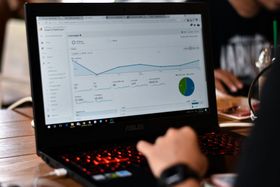9 Best Strategies for Optimizing Pay-Per-Click Performance in 2025
Explore the world of PPC and supercharge your results with these highly effective strategies.
Updated February 11, 2024.

Pay-per-click (PPC) advertising revolutionized online marketing when it emerged in the late 1990s with pioneer platforms like GoTo.com (later Overture) and Google AdWords (now Google Ads). Its appeal lies in its ability to deliver targeted results through a pay-for-performance model, where you only pay when users click on your ads. Here's how you can optimize your PPC strategies for measurable outcomes.
Maximizing PPC ROI requires a strategic blend of data analysis, ongoing optimization, and a deep understanding of market conditions and your own business objectives. Here are some strategies to consider.
1. Understand the value of a conversion
Understanding customer lifetime value (CLV) allows you to determine a reasonable cost-per-acquisition (CPA) for your PPC campaigns. If you know that a customer's lifetime value is $1,000, and you want a profit margin of 50%, you can afford to spend up to $500 to acquire that customer. This CPA can then guide your budgeting decisions.
» Learn how to calculate your conversion rate.
2. Leverage smart bidding strategies
Smart bidding strategies leverage machine learning to optimize for conversions in every auction through a feature known as "auction-time bidding." Tools like Google's Target CPA or Target ROAS (Return on Ad Spend) can automatically adjust your bids based on the likelihood of a search leading to a conversion.
Setting these targets based on your desired CPA or ROAS allows the algorithm to find the optimal bid for each scenario, potentially increasing conversions while controlling costs. This lessens the burden of control on your end, automating a process with pre-defined variables.
3. Optimize for quality score
In Google Ads, your Quality Score is a metric that influences your ad rank and the cost-per-click (CPC) of your ads. It considers the relevance of your keywords, the quality of your ad copy, and the landing page experience.
Achieve a higher Quality Score with these steps:
- Select targeted keywords
- Craft clear and persuasive copy
- Ensure your copy aligns with your brand
- Develop a fast-loading, user-friendly landing page that addresses your audience's needs
By improving these elements, you can achieve a higher Quality Score, leading to a lower CPC and better ad positioning.
4. Consider seasonality and adjust accordingly
Consumer behavior fluctuates with seasons, holidays, and market shifts, impacting PPC campaign performance. Analyzing trends and historical data can help you anticipate these changes so you can make budget adjustments.
For example, a business in the retail sector may increase PPC during holidays to capture high traffic, while a tax service provider might increase spending during tax season. Aligning budgets with these changes optimizes traffic and boosts ROI in peak periods.
» Need help optimizing your seasonal PPC performance? Hire a PPC consultant with Mayple.
5. Select the right keywords for your PPC campaigns
Selecting the right keywords is paramount in running a successful PPC campaign, as they are the conduits through which potential customers find your ads. Here are vital considerations for keyword selection:
- Relevance: Keywords must be highly relevant to your products or services. The more targeted your keywords are, the more likely you will attract qualified traffic.
- Search volume: Finding the right keywords is about balancing search volume and competitiveness. High-volume keywords can be costly, so opting for moderately searched terms can be cost-effective while still driving traffic.
- Intent: It's vital to grasp user intent to use the right keywords. Keywords fall into categories like navigational, informational, and transactional. Prioritizing transactional keywords in PPC campaigns can enhance conversions, increase sales, and drive revenue.
- Competition: Taking a moment to weigh the pros and cons of competitive keywords is a smart move. Opting for niche, less competitive keywords can often lead to a better ROI strategy.
- Cost: You want to analyze the cost of keywords in relation to their potential return. Expensive keywords are okay if they convert well and provide solid ROI. The goal is to maximize the revenue generated for each dollar spent.
6. Use negative keywords to streamline PPC campaigns
Adding negative keywords tells your PPC platform not to show your ad for those specific terms. This helps avoid unqualified traffic that is unlikely to convert, thus saving your budget for more fruitful prospects.
For example: Adding negative keywords like "wine glasses" would help avoid unnecessary clicks if you sell eyeglasses.
Negative keywords help you refine your targeting. For instance, if you're selling high-end products, you might add "cheap" or "free" as negative keywords to ensure you're not spending money on clicks from users looking for low-cost solutions.
» Learn more with the top PPC books every marketer should read in 2025.
7. Use ad extensions to achieve better click-through rates
Ad extensions are additional pieces of information or call-to-action buttons that can be added to online ads to provide more context and encourage user engagement. The focus should be on adding value and relevance—such as providing quick links to specific products via site links or showcasing unique selling points with callout extensions.
- Example 1: A travel agency's PPC ad might feature copy like "Escape to Paradise: Exclusive 30% Early-Bird Discount on Tropical Resorts — Book Now" with site link extensions for "Last-Minute Deals" and "Family Packages," which offers both a clear benefit and direct pathways to targeted landing pages.
- Example 2: A tech company could use a headline like "Ultra-Fast, Secure Web Hosting — Get Started in Minutes" with callout extensions like "99.9% Uptime Guarantee" and "24/7 Tech Support," directly speaking to the critical concerns of reliability and customer service that their potential customers have.
These examples demonstrate tailored messages that match user queries with specific, actionable insights, significantly improving the chances of a click and subsequent conversion.
8. Optimize your landing page
Optimizing your landing page is vital because it's the destination where conversion actions take place after a prospect clicks on an ad. The alignment between ad copy and landing page content, the ease of navigation, the message's clarity, and the simplicity of the conversion all directly impact conversion rates.
To create a high-converting Google Ads landing page, we recommend the following:
Ensure clarity and cohesion between the message and design
The landing page design should echo the ad's message without distractions. For a "30-Day Free Trial of Productivity Software" ad, the landing page should prominently feature the offer with clear navigation, using design elements like white space, colors, and targeted copy to guide users seamlessly toward the conversion goal.
Use persuasive and concise copy with a clear call to action (CTA)
The copy on your landing page should be concise and compelling, emphasizing the offer's benefits. Every word should contribute to a persuasive narrative, creating a clear, actionable CTA. The button should visually stand out and feature text creating urgency or incentive for purchases, sign-ups, or downloads.
For example: Instead of a generic "Submit" button, use action-oriented language like "Get My Free Guide Now!" This strategy taps into the user's desire for immediate reward and can markedly boost conversion rates.
Leverage trust elements and social proof
Leveraging social proof like testimonials, trust badges, and partnerships can enhance trust. For instance, you could place compelling testimonials close to the call-to-action on a landing page to reassure visitors. For financial services, showcasing security badges and success stories reinforces reliability.
Highlighting media features and brand partnerships can also boost trust and prestige. Social proof doesn't just tell visitors why they should act; it shows others who benefit—a potent motivator.
» Keep ahead of your PPC efforts with 7 trends to supercharge your advertising in 2025.
9. Address ad targeting and audience segmentation
Ad targeting and audience segmentation in your PPC campaigns are essential for ensuring that the right message reaches the right audience at the right time. This process involves defining your ideal customers and how best to reach them.
Here are some methods and tools that are particularly effective at finding your target audience:
Built-in platform tools
Platforms like Google Ads and Facebook have incredibly effective targeting options. Google Ads allows targeting based on search terms, user intent, location, device, and more.
For example: You can target users searching for "best running shoes" and refine them by location, indicating immediate purchase intent.
Paid advertising on Facebook provides detailed demographic targeting, including interests, behaviors, lifestyle choices, travel, and more.
For example: You could target users interested in fitness and health who have engaged with similar pages to your brand.
Audience segmentation using analytics
Studies show that 81% of executives find segmentation crucial for growing profits, and Google Analytics can be a treasure trove for audience segmentation. By analyzing your website traffic, you can identify different segments based on users' behavior, such as the pages they visit, the amount of time they spend on the site, and their conversion paths.
This information can inform your marketing strategy by highlighting which segments are most engaged and likely to convert, allowing you to tailor your PPC campaigns to these specific groups.
Integrate your PPC campaigns with a CRM tool
Use data like past purchases to create lookalike audiences to target new prospects who share similar characteristics with your best customers. This can significantly improve the relevance of your ads and the likelihood of conversion.
» Read up on great ways to find keywords for PPC campaigns.
PPC performance perfection
Optimizing PPC performance can help drive targeted traffic, boost conversions, and maximize ROI. It ensures efficient ad spending, allowing you to reach the right audience and increase revenue over time. All of this is pivotal for your business's growth and competitiveness in the market.
Speak to us at Mayple to get matched quickly and easily with the perfect PPC consultant who aligns with your brand and can optimize your PPC performance.






